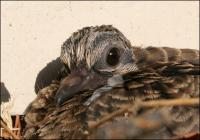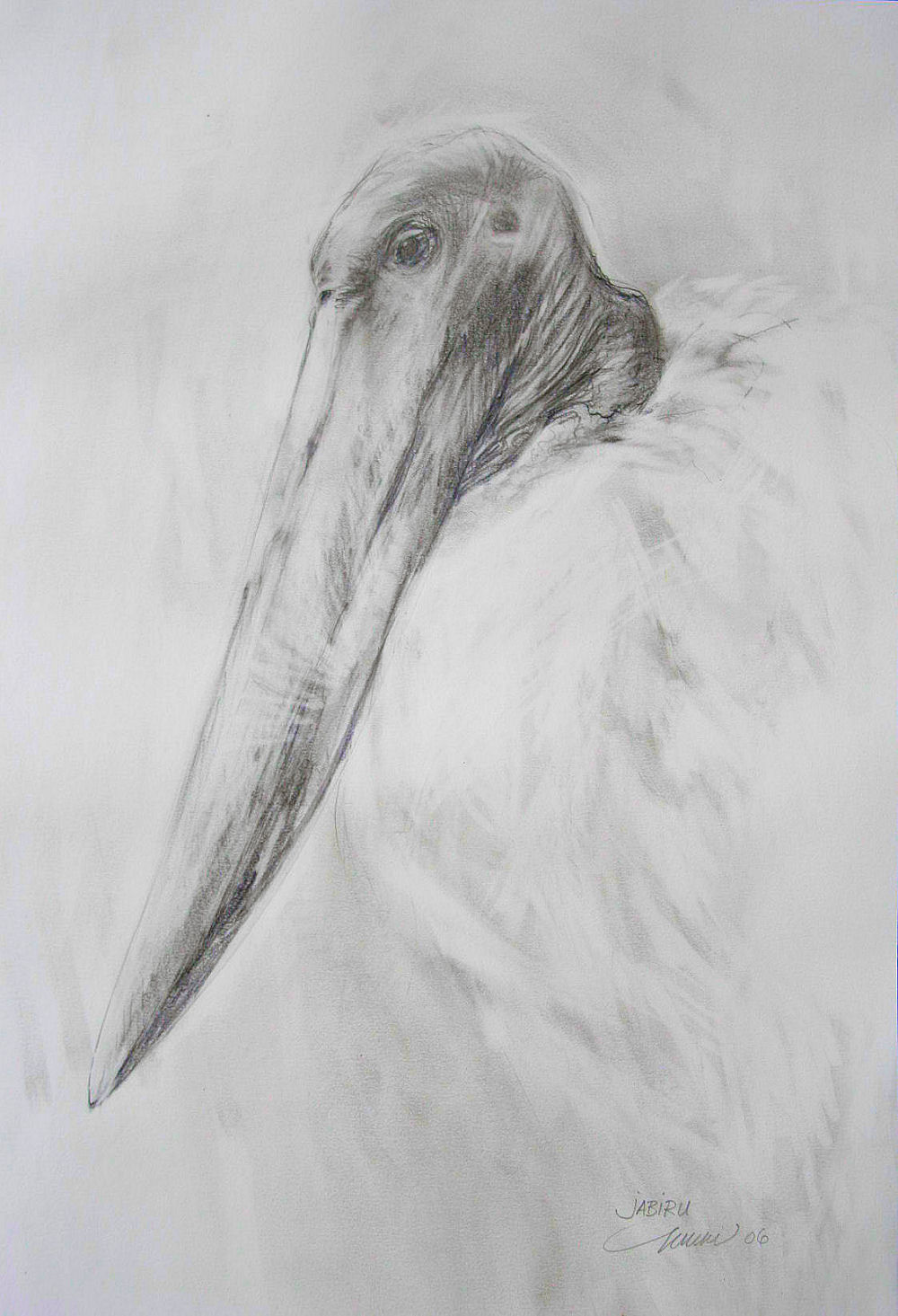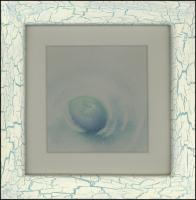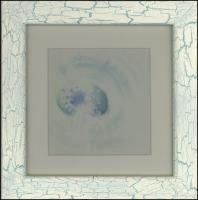birds
« Previous Entries Next Entries »Exhibition Opportunity
Tuesday, December 4th, 2007

Galahs in Traffic, Australia. 14H x 11W oil pastels on paper, has 3-inch-wide white double mat and 26H x 22W inch white custom-built white wood frame with crackle finish.
Flocks of Galahs fly in front of cars… unfortunate fatalities along the highway to the Kangaroo Island ferry, South Australia. The trees illustrated are Norfolk Island Pines.
One of the pieces showcased in the AJAS Fall/Winter Online Gallery.
For Artists interested in juried competitions and online gallery exhibitions, the American Juried Art Salon (AJAS) gives helpful feedback and critique whether your work is accepted or not. For information about their Spring/Summer 2008 competition visit http://www.artjury.com/art.html Artists whose work has been accepted twice in a row receive a website page for one year.
Male Cardinal
Saturday, October 6th, 2007
Male Cardinal at the Dallas Arboretum, Dallas TX, 24H x 24W inches acrylics and masking medium on canvas, trim frame. Sold.
Cardinals are one of my favorite subjects. On walks I see them in the open, but good photos of them are elusive, as they hide just beyond the branches so perfect shots are next to impossible. Branches here are partially in front, placed around the bird in the abstract shape of a nest. The cardinal in the painting really is that chubby. He is well fed at the Dallas Arboretum.
There were two separate applications of masking medium, used traditionally in watercolor paintings. Second phase: trying to highlight the bird’s interaction with its environment and hoping to find a way to do more than provide the expected sort of cardinal portrait. Adding Pthalos Blue wash changes the mood and the season, maybe even the time of day…interesting what one or two brushes of color can do.
 One male Cardinal returns regularly to our yard with his mate who chirps quick, sharp notes. I discovered this when thinking that our air conditioner needed servicing, and going out to see what the consistent squeaking was. The pair laid eggs in one of our back yard bushes during May this year. I half-hoped the eggs would be red! The nest was made to perfection with a tightly woven bowl of dry grass, leaves, twigs, and pieces of plastic garbage, so artfully crafted.
One male Cardinal returns regularly to our yard with his mate who chirps quick, sharp notes. I discovered this when thinking that our air conditioner needed servicing, and going out to see what the consistent squeaking was. The pair laid eggs in one of our back yard bushes during May this year. I half-hoped the eggs would be red! The nest was made to perfection with a tightly woven bowl of dry grass, leaves, twigs, and pieces of plastic garbage, so artfully crafted.
Peace by our back door
Thursday, August 30th, 2007
This is the second time around for doves nesting in the wreath by our back door. I’m sure it’s the same pair who devotedly cared for two eggs, taking turns in shifts as they are now. The chick in the second thumbnail is from the first brood hatched in May. It mysteriously disappeared after two days and the other egg didn’t hatch. There was no trace of that chick anywhere..no body, bones, feathers..nothing. It was not old enough to fend for itself – could the parents have eaten it I wonder? Maybe there was something wrong with it, or the parents were first-timers. The lizards and salamanders around here are too small to eat a meal that size, and other birds would not have been brave enough to come so near to the door I don’t think. Nature takes care of itself though, so no tears. Hopefully these ones will survive and we can watch them mature.
Sept. 3rd: One of the chicks hatched! There were about six Starlings on the roof overlooking the evestrough, which is not usual for them – at our house anyway- so I’m thinking maybe they are interested in robbing the chick from it’s nest. Maybe they were the egg-robbers from the first nest.
Sept. 4th: The chick appears to be so much larger today, and it’s the first time I’ve seen it so exposed. It seems so vulnerable on that small flimsy nest.
Sept. 5th: The chick has been left on its own a lot in the past 24 hours, also becoming quite vocal. The other egg is unlikely to hatch.
Sept.9th: The nest is overcrowded. The chick ruffled its feathers and snapped its tiny beak at me when I took these photos – the instincts are strong – how sweet is that?!
Sept. 11th: When the parent sitting on the chick is up in the air above the nest, it’s time for little chicky to leave! That’s what I thought the day before the chick flew away, and sure enough it was time. It’s so funny when the parent sits on top of the chick trying to hide it – there is hardly enough room for two in the nest, and she/he is not fooling anybody!
Sept. 12th: Fortunately I walked out just in time to see the chick fly from the ground to the fence nearby. There it remained for about 90 minutes then it was gone. That night I wondered where it would be sleeping, and if it was truly on its’ own now without parents, how it would survive. Less than a month before it was not even in the form of an egg!!
Sept 13th: didn’t expect to see it again, but while sitting outside at dusk, there they were, the mom (or dad) and chick. It was so pleasing to see them sitting on the fence together.
Sept 16th: I still see the little one come into the yard, much bigger now. It is smaller than an adult, and I’m sure that must be the same chick. Full circle!
Jabiru
Friday, September 1st, 2006
Jabiru at the Dallas World Aquarium, 24H x 18W inches graphite on paper
Post-dated note: Accepted in the J. Mane Gallery’s Fins, Feathers and Fur 2020 exhibition, unfortunately no longer shown in the gallery archives in 2022.
“Drawings have a job to do: to provide viewers with more than just a pretty picture. There are tones implied through those tones!”
Jabiru are large South American prehistoric-looking birds standing 4-5 ft. high. Reference photos for ‘Jabiru’ were taken at the Dallas World Aquarium, where I’ve spent many visits watching a pair of them interact. Fortunately, I can usually study them in silence, because everyone else’s attention is on the flashy coral-colored flamingos just down the aisle.
Before starting I envisioned a drawing based on Japanese principles of using fewer lines and shading, with empty spaces considered as much a part of the drawing as every mark.
This is not the prettiest subject, precisely one of the reasons I chose to keep the drawing soft. By purposely compromising the values and using a lighter touch, my hope was that the viewer’s response might be pleasant before thinking “ugly bird”. To explain further, the Jabiru’s feathers are pure white and its head including beak are very dark grey, almost black. I was stubborn about the style staying gentle and simple, having negative space speak as much.
Whereas a photograph utilizes the whole range of dark and light values, copying everything, a person chooses the amount and quality of dark and light values to apply in order to attain the intended the effect on our emotional impressions.
The Jabiru’s huge beak strikes a strong silhouette by shape alone, so to lessen the impact of the large, odd shape on a fairly empty page, extremes were avoided even though the bird’s beak is quite dark in reality.
I really want stress here that a drawing is not a photograph, and a photograph is not a drawing. Photographs might be the source of inspiration and for details that memory has missed or forgotten. Illustrations that are copied with attempts to produce an exact visual likeness, relying purely on the photo, lack a certain warmth no matter how well rendered they are. Art involves the human factor. A photo is a product of a machine; the visual details are copied with no sense or emotion; it does what it’s been designed to do. Drawings are subjective representations of all that we sense as well as see.
We interpret character of a subject not only visually, but also through our multidimensional senses.
Galahs in Traffic, reworked
Friday, April 14th, 2006

Galahs in Traffic, 14H x 11W inches oil pastels on paper, has 3-inch-wide white double mat and 26H x 22W inch white custom-built white wood frame with crackle finish.
Flocks of Galahs fly head on into cars on the highway while driving to the Kangaroo Island ferry, South Australia. A tragic phenomenon – many lay dead on the side of the road, for miles. This is a busy highway, and next to stopping, it was almost impossible to miss them.
This started out to be a drawing of the Norfolk Island Pines growing in the south-central coastal regions of Australia. It’s not unusual for me to completely re-work oil pastel drawings after a day or two of work, when they could be called finished. Sometimes after a period of study, radical changes are in order, as in this case. After two days of work, while recalling the horrifying scene that day, it was clear that the style in the first stage of the drawing was stagnant and ordinary. Adding the blurry, in-your-face Galah is much more effective. See the first version here.
Post-dated note in 2007: Galahs in Traffic placed in Artjury.com’s 2007 Fall/Winter Juried Online Exhibition.
Post-dated note, 2022: Accepted in the J. Mane Gallery’s Fins, Feathers and Fur 2020 exhibition.
Galahs in Traffic, version 1
Wednesday, April 12th, 2006

Galahs in Traffic, version 1 – this drawing started out to be a portrait of the Norfolk Island Pines growing in this coastal area of South Australia. Many of the oil pastel pieces in the Paper Places series have a first stage at the end of a day or two worth of work where it could be called finished, then after studying for a few days, months or even years, if it’s not dynamic enough it may need to be changed.
This is an area unlike any other, where flocks of Galahs flew directly into the traffic on the main highway leading to the Kangaroo Island ferry. Dead Galahs lay along the side of the road for miles. After two days of work and recalling the horrifying feelings of seeing all those dead birds, it’s clear that the drawing as it is in the stage above, is stagnant and kind of ordinary even though it could be called finished. The style needs reworking because of the subject matter and what takes place there every day.
Eneggma
Tuesday, April 11th, 2006
Eneggma, set of 4H x 4W dry pastels on paper, part of sketches prepared for “The Perfection of Small Birds” by American Poet Hannah Gerber. Frames use crackle glaze and off-white acrylics over robin-egg blue. Sold.
Dust Bath
Monday, April 10th, 2006
Dust Bath, 4H x 6W inches dry pastels on charcoal paper, for Hannah Gerber’s The Perfection of Small Birds
Chickadee 02
Sunday, April 9th, 2006

Chickadee 02, 4H x 6W inches charcoal on paper, another sketch for Hannah Gerber’s The Perfection of Small Birds
Chickadee 01
Saturday, April 8th, 2006
Chickadee 01, 8 x 10 inches charcoal on paper, for The Perfection of Small Birds, by Poet Hannah Gerber
Hannah was only looking for cover Art, but when commissioned to do only one design a lot of preliminary sketches are presented also, partly as a way of warming up but also to give clients a selection. As a result, extras were also used on inside pages.
« Previous Entries Next Entries »






















